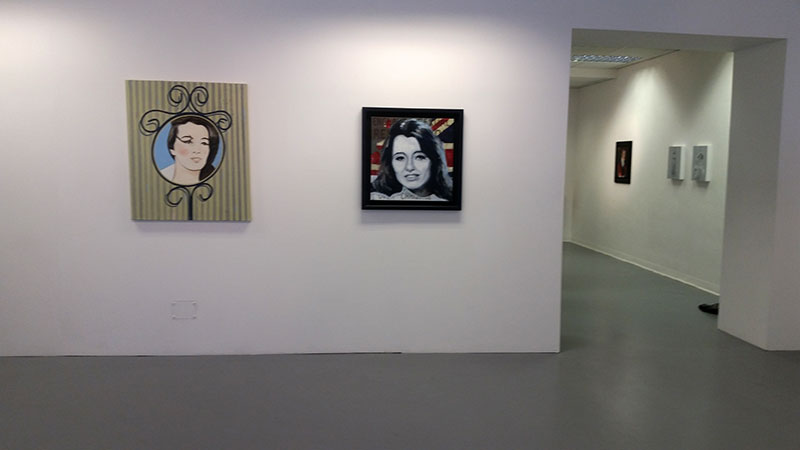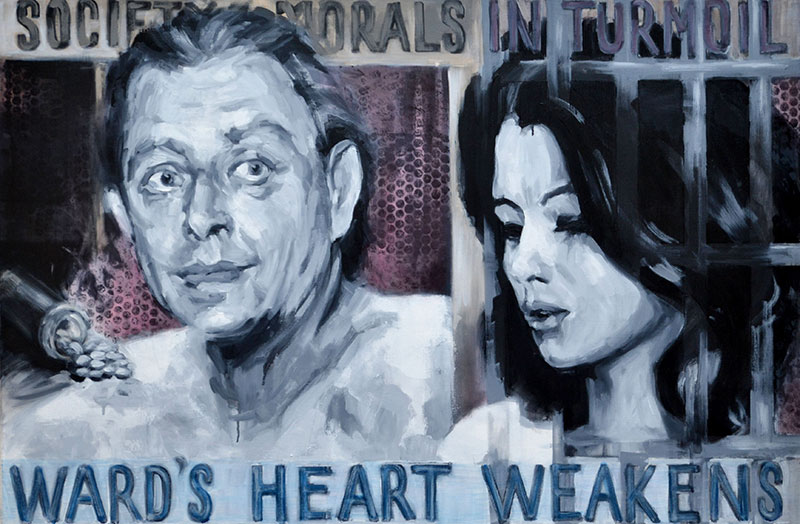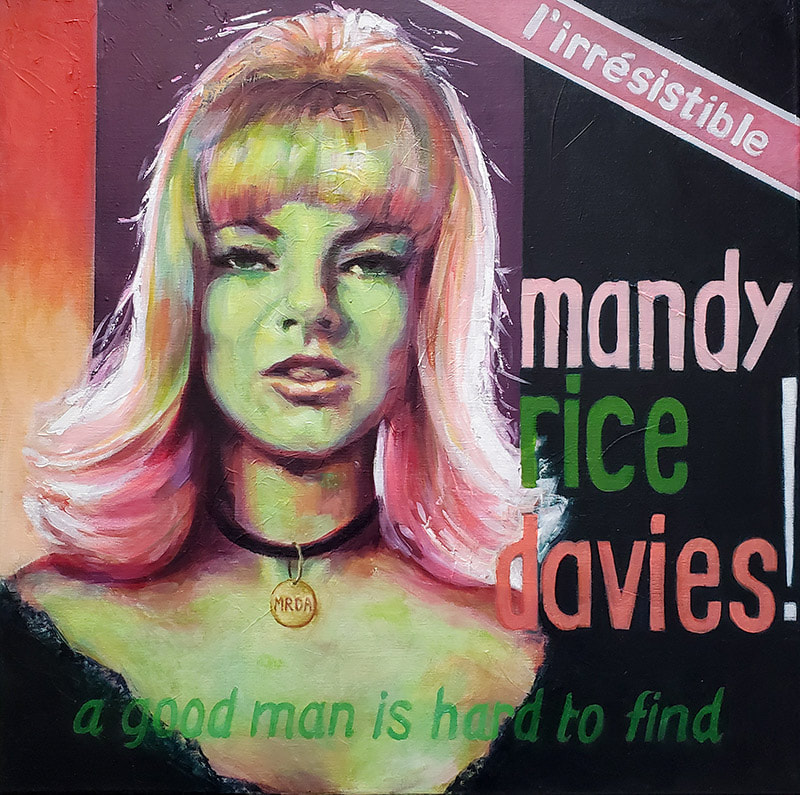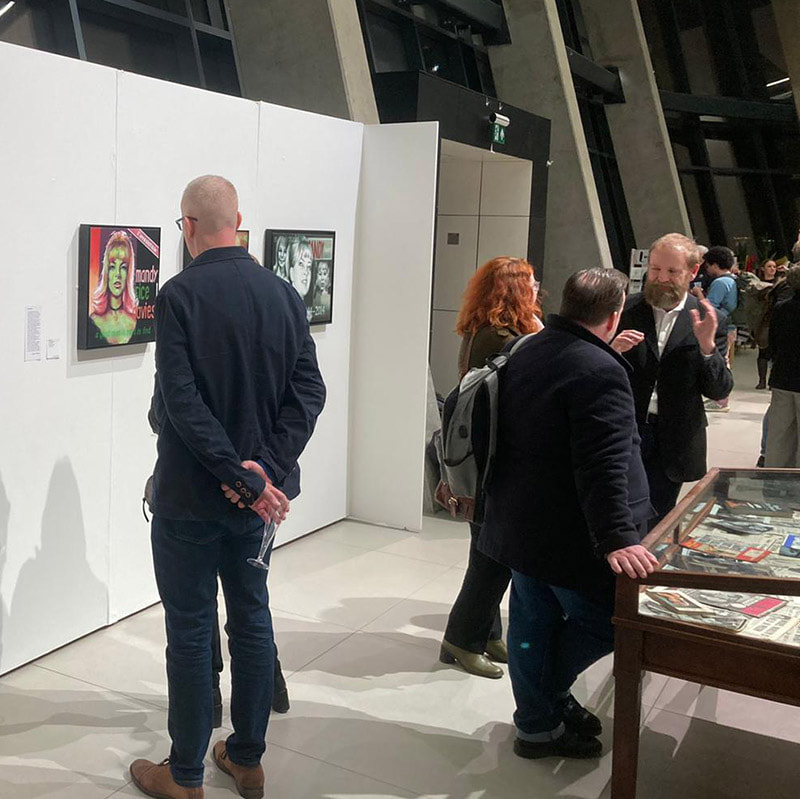'Dear Christine' - A Tribute to Christine Keeler
A touring exhibition 2019 Vane Gallery Newcastle, Elysium gallery Swansea, 2020 Arthouse 1 London
‘Dear Christine’ aims to reclaim and reframe Christine Keeler (1942-2017), a woman castigated for her role in a notorious political scandal in the Sixties. The Profumo Affair was a watershed moment in British cultural and political history which brought down the government of the time. Keeler was shamed in the tabloid press and suffered its full wrath as the dawn of the sexual revolution approached. Keeler, it could be argued, inadvertently challenged the prevailing morality of the time and the hypocrisy of the establishment. (from the press release) curated and conceived by Fionn Wilson.
Find out more about Christine Keeler here: https://www.christine-keeler.co.uk/
Images from the Vane gallery exhibition and my 3 paintings below.
A touring exhibition 2019 Vane Gallery Newcastle, Elysium gallery Swansea, 2020 Arthouse 1 London
‘Dear Christine’ aims to reclaim and reframe Christine Keeler (1942-2017), a woman castigated for her role in a notorious political scandal in the Sixties. The Profumo Affair was a watershed moment in British cultural and political history which brought down the government of the time. Keeler was shamed in the tabloid press and suffered its full wrath as the dawn of the sexual revolution approached. Keeler, it could be argued, inadvertently challenged the prevailing morality of the time and the hypocrisy of the establishment. (from the press release) curated and conceived by Fionn Wilson.
Find out more about Christine Keeler here: https://www.christine-keeler.co.uk/
Images from the Vane gallery exhibition and my 3 paintings below.
The name Christine Keeler is so full of connotations that it is no longer associated with an individual identity it’s a story. Christine Keeler, once a real person, is now a fictional character, a modern myth.
Possibly the first tabloid celebrity, Christine Keeler is a British institution; an icon, if you like, associated with a particular period in British history. Her behaviour and attitude were ahead of her time, she became the woman who unintentionally rocked the establishment and shocked the nation. She can be seen to symbolise women’s freedom and liberation on one hand and yet was also a victim, used and betrayed by men in positions of power. The media used her but she also courted them to a certain extent, paving the way for the rise of celebrity culture we are now so familiar with.
Influencing and frequently determining how subjects are represented and judged by others; the press broke the scandal to the public. The papers hounded her for a story, persuading her to ‘tell all’, then embellished the facts and used her as a target for blame; which shifted emphasis away from police corruption and the unsavoury behaviour of government officials.
My paintings represent the role and responsibility of the press in the Christine Keeler story. They are a montage of images and text with a limited palette range referencing colours associated with the tabloid press and a dated look, they depict the press darling, the rebel icon and the fallen angels.
‘I Took on The Sins of a Generation’
‘God Save Christine’
‘Ward’s Heart Weakens’
Possibly the first tabloid celebrity, Christine Keeler is a British institution; an icon, if you like, associated with a particular period in British history. Her behaviour and attitude were ahead of her time, she became the woman who unintentionally rocked the establishment and shocked the nation. She can be seen to symbolise women’s freedom and liberation on one hand and yet was also a victim, used and betrayed by men in positions of power. The media used her but she also courted them to a certain extent, paving the way for the rise of celebrity culture we are now so familiar with.
Influencing and frequently determining how subjects are represented and judged by others; the press broke the scandal to the public. The papers hounded her for a story, persuading her to ‘tell all’, then embellished the facts and used her as a target for blame; which shifted emphasis away from police corruption and the unsavoury behaviour of government officials.
My paintings represent the role and responsibility of the press in the Christine Keeler story. They are a montage of images and text with a limited palette range referencing colours associated with the tabloid press and a dated look, they depict the press darling, the rebel icon and the fallen angels.
‘I Took on The Sins of a Generation’
‘God Save Christine’
‘Ward’s Heart Weakens’
Scandal '63 Revisited
Reframing the Profumo affair via Art and Artefact
Exhibition at The Gallery De Montfort University 3rd March - 15th April 2023
Images below: The three paintings of Mandy Rice-Davies I produced for the exhibition and photos from the private view evening.
The paintings reference the post-scandal Mandy - Mandy the performer, the celebrity and the ‘It’ girl, featuring images from an E.P. cover, footage of interviews and news reports on her death in 2014.
Images below: The three paintings of Mandy Rice-Davies I produced for the exhibition and photos from the private view evening.
The paintings reference the post-scandal Mandy - Mandy the performer, the celebrity and the ‘It’ girl, featuring images from an E.P. cover, footage of interviews and news reports on her death in 2014.
Mandy Rice-Davies, born (Marilyn Davies) in Wales, was the daughter of a police officer. She grew up in the West Midlands, and at 16 she went to London as Miss Austin at the Earl’s Court Motor Show, before securing a job as a dancer at Murray’s Cabaret Club in Soho. There she was befriended by Christine Keeler and Stephen Ward and became enmeshed in ‘The Profumo Affair’ (1963), which toppled Harold MacMillan's government.
Ironically, Mandy Rice-Davies never met John Profumo, but once the affair made headlines she was constantly in the news. She was most celebrated at the time for her court reply about Lord Astor, ‘He would, wouldn't he?’, (when told he denied having an affair with her) for which she earned herself a place in the Oxford book of Quotations. Mandy Rice Davies Applies (abbreviated MRDA) is used to this day as an acronym to imply that someone is lying to protect their own interests.
Unlike Christine Keeler, Mandy’s notoriety from the scandal worked in her favour. She revelled in the limelight and came across as confident and witty in front of the camera. She held her head high, had no secrets and no regrets. She got on with her life, making the most of the publicity her newfound, ‘celebrity status’, gave her. In 1964, the year after the scandal, she recorded an EP and released The Mandy Report, a comic-style memoir of her rise to fame. She went on to travel extensively, performing and singing cabaret. Later, she wrote books, opened restaurants and clubs and appeared in a number of television, film and stage productions and was happily married for 25 years. Not surprisingly, she described her later life as a ‘slow descent into respectability’.
'L'Irresistible (2022) is based on the French release of her 1964 E.P. on Ember records, Introducing Mandy. The tracks include covers of All I Do is Dream of You, You’ve Got What it Takes, A Good Man is Hard to Find, and Close Your Eyes. In the painting a tag has been added to the choker she wears around her neck, referencing her entry in the Oxford dictionary of quotations.
The media filmed an interview with Mandy in the airport lounge when she returned to the UK after a singing and cabaret tour of Germany in February 1964. Arrival (2023) captures her mid-sentence, emphasises the distortion of the film footage and uses an invented colour palette.
The painting composition of No Regrets (2023) is a montage of images taken from TV news coverage of Mandy’s death from cancer in 2014 (including photos of her from the scandal in 1963 and one of her later in 2013, combined with text referencing the news footage).
'Sixty Years Later' Article by Tara Hanks: https://tarahanks.com/2023/11/13/sixty-years-later-scandal-63-revisited/
Ironically, Mandy Rice-Davies never met John Profumo, but once the affair made headlines she was constantly in the news. She was most celebrated at the time for her court reply about Lord Astor, ‘He would, wouldn't he?’, (when told he denied having an affair with her) for which she earned herself a place in the Oxford book of Quotations. Mandy Rice Davies Applies (abbreviated MRDA) is used to this day as an acronym to imply that someone is lying to protect their own interests.
Unlike Christine Keeler, Mandy’s notoriety from the scandal worked in her favour. She revelled in the limelight and came across as confident and witty in front of the camera. She held her head high, had no secrets and no regrets. She got on with her life, making the most of the publicity her newfound, ‘celebrity status’, gave her. In 1964, the year after the scandal, she recorded an EP and released The Mandy Report, a comic-style memoir of her rise to fame. She went on to travel extensively, performing and singing cabaret. Later, she wrote books, opened restaurants and clubs and appeared in a number of television, film and stage productions and was happily married for 25 years. Not surprisingly, she described her later life as a ‘slow descent into respectability’.
'L'Irresistible (2022) is based on the French release of her 1964 E.P. on Ember records, Introducing Mandy. The tracks include covers of All I Do is Dream of You, You’ve Got What it Takes, A Good Man is Hard to Find, and Close Your Eyes. In the painting a tag has been added to the choker she wears around her neck, referencing her entry in the Oxford dictionary of quotations.
The media filmed an interview with Mandy in the airport lounge when she returned to the UK after a singing and cabaret tour of Germany in February 1964. Arrival (2023) captures her mid-sentence, emphasises the distortion of the film footage and uses an invented colour palette.
The painting composition of No Regrets (2023) is a montage of images taken from TV news coverage of Mandy’s death from cancer in 2014 (including photos of her from the scandal in 1963 and one of her later in 2013, combined with text referencing the news footage).
'Sixty Years Later' Article by Tara Hanks: https://tarahanks.com/2023/11/13/sixty-years-later-scandal-63-revisited/















